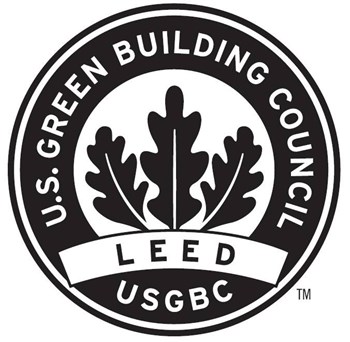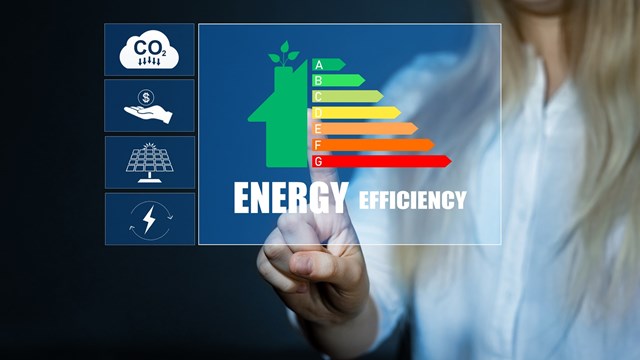
There are two ways—and only two ways—to balance a budget: increase revenue or decrease spending. Whether you’re the treasurer of a co-op board or the President of the United States, those are the only two levers at your disposal.
Energy is no different. With the global population soaring, with oil reserves plateauing just as new markets are emerging in China and India—and with the climate changing at an unsustainable rate—the need to both increase sources of energy and conserve the ones we have has never been more vital.
The Gold Standard
Since it was first implemented 20 years ago, the U.S. Green Building Council (USGBC)'s LEED certification has been the gold standard when it comes to measuring a building's environmental conscience. Being LEED certified at any level means that much thought and planning was put into a building before ground was even broken to begin construction. LEED buildings have an array of advantages over non-certified buildings – some of which are wallet-based, some of which are body- and health-based.
According to the USGBC, the residential market—from multi- to single-family, from market rate to affordable housing, is reaping the benefits of using green building techniques. Since the launch of LEED for Homes in 2008, more than 39,000 homes have received LEED for Homes certification and over 111,000 are registered for certification. Over half of all LEED-certified homes are in the affordable housing category, the USGBC says.
Newark’s Richardson Lofts and Jersey City’s Madox Apartments are two standout examples of energy efficiency done right.
Richardson Lofts, which opened in 2012, consist of 67 units and earned Platinum LEED certification, the highest level attainable. The building, originally a jewelry factory built in 1904, features several environmentally-friendly amenities, including a green roof and high efficiency heating and cooling systems.
Madox Apartments was the first residential building in Hudson County to earn a Silver LEED certification. The building was built on reclaimed urban land, is equipped with solar panels on the roof and uses renewable resources to fuel 35 percent of its energy needs.
LEED-ing the Way
What is LEED? Why is it the golden standard? How can boards go about making their buildings LEED-certified? And would they want to?
In 1993, a troika of prescient industry experts—Rick Fedrizzi, David Gottfried and Mike Italiano—founded the U.S. Green Building Council, to promote sustainability in building and construction. They gathered representatives from a wide swath of architecture firms, and set to work on a system to rate buildings according to how “green” they were. Seven years later, the Leadership in Energy and Environmental Design—LEED—building certification system was unveiled, consisting of a series of criteria to quantify how energy efficient buildings are.
“In the early days LEED was a program that attracted architects and then engineers and then designers,” explains Fedrizzi. “And you look at LEED today and the audience around the world that we are attracting it’s astounding. We all come together of the common thread: sustainability. I think LEED does that better than any other organization out there. The idea that we can better understand our world, energy, water or waste materials innovation, and understanding all those things and yet applying them to our lives so that we become more productive in our daily life and in our daily business and to ultimately leave a better world behind.”
“It’s expanded since its inception,” says David Ahrens, president of the New York chapter of the Association of Energy Engineers (AEE). “Right now, it consists of nine different ratings systems.” The nine systems represent nine different categories of buildings. The ones relevant to residential buildings are:
New Construction: Here, LEED has made a quantifiable difference. Since 2004, most major new construction seeks to have some form of LEED certification.
Core and Shell: “Not what’s inside,” Ahrens explains, but the exterior of a building and its central systems.
Existing Buildings: Operations & Maintenance (EBOM) A green HVAC system and state-of-the-art windows go a long way.
By the Numbers
Each category is broken down into a series of indices, and each index is rated. The score is then aggregated, and the result is a number from 1-100. Forty to 49 is LEED-certified; 50-59 is silver; 60-79 is gold; and above 80 is platinum, Ahrens explains.
In October 2012, the chemical company BASF’s North American Headquarters in Florham Park became the fifth construction project in the United States and the first in New Jersey to receive LEED double Platinum certification. Three sites on the West Coast and one in Michigan are the only other projects that have achieved the LEED double Platinum designation.
The USGBC recognized the 325,000-square-foot building for incorporating sustainable practices and reducing its carbon footprint by achieving superior efficiency in lighting, energy, water and material use. A few of the intelligent building technologies employed throughout the building include low plumbing fixtures that reduce indoor water usage by an estimated 40 percent, a landscape plan that incorporates native and non-invasive plants that require 85 percent less water to survive and natural daylight that illuminates 75 percent of the interior while 90 percent of the space looks out onto a lush park-like setting.
“There are multiple advantages to the LEED-compliant design,” says John C. Schmidt, manager, corporate media relations for BASF in Florham Park. “From an energy perspective, the building has high performance glass, energy-efficient air handling units, state-of-the-art energy-efficient lighting, occupancy sensors and Energy Star rated equipment including computers and office equipment. The green power credit encourages the development and use of renewable energy technologies, and requires that at least 35 percent of the building’s energy come from renewable sources; in fact, 50 percent of the electricity of the building is supplied by renewable energy sources.”
LEED EBOM recognizes superior performance in five core categories: sustainable sites; water efficiency; energy and atmosphere; materials and resources; and indoor environmental quality. It also recognizes innovation in operation and designates certain priorities based on a building’s geographic location. This is important, because most residential buildings seeking LEED certification are existing buildings, and this will strive for LEED EBOM certification.
Getting Certified
Another organization, the third-party Green Building Certification Institute, provides the certifications. “It certifies individuals as LEED-accredited professionals,” says Ahrens. Certification involves learning about the LEED system, about conservation of building resources, about how to make existing buildings more green.
Not long ago, this sort of environmental movement was the provenance of dreamers and hippies. Now it is something that unites people from across the political divide.
“The idea that you could be green in a cost-effective way is very compelling,” says Ellen Honigstock, the USGBC’s director of construction education and an architect. Once the organization showed the way to achieve energy efficiency, the idea took off. To green your building, Honigstock says, “start to figure out what you already have, how you perform.” The initial steps involve analyzing the usage of energy and establishing benchmarks. “Benchmarking is when you calculate the amount of energy used,” she explains. Then, the professionals get involved. “Architects do an analysis—how to improve windows, lights, heating.” The architects and engineers, she says, will provide estimates on what the upgrades to existing buildings will cost. “There are government initiatives to offset the costs,” she says.
“It’s a fairly expensive process,” she concedes. The up-front price tag is one of the barriers to a wider acceptance. Boards look at the capital investment and get nervous. The idea that a building should spend money now to plan for the future is, in many cases, not the way boards tend to think. Budgets are hard enough to calculate without start-up costs.
The other hurdle is lack of knowledge. In most co-ops and condos, the property managers are the agents of change. They’re the ones who spot trends and advise buildings to try new things. But property managers tend not to be among the many professionals who hold LEED accreditation.
“You know what building managers do. They’re busy. They don’t have time,” Honigstock says. “Boards have to ask managers to do it,” to get the LEED training. “Request an agent to get trained and make the changes,” she advises.
Honigstock believes that getting LEED certification for a building is the single best thing anyone on a board can do for the environment. When asked point-blank if there were any benefits to not moving to a LEED-certified system, Honigstock says, pointedly, “None.”
The push for green buildings has happened at a stunning rate of speed. LEED was still in the larval stages 20 years ago. The ratings systems have only been around for 13 years. The Green Building Certification Institute has only been awarding certifications for five years—a blink of the eye.
It’s not going to happen overnight and changing to a more eco-friendly state of mind takes time. But experts believe that the fact that so many buildings have gone green is a great boon for the environment.
Greg Olear is a freelance writer and a frequent contributor to The New Jersey Cooperator. Staff writer Christy Smith-Sloman contributed to this article.






Leave a Comment